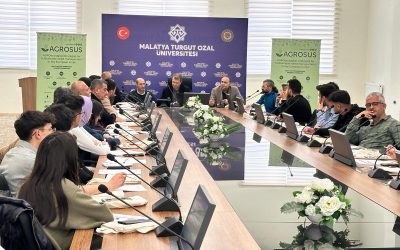Anatolian region
The Anatolian Biogeographic Region covers the interior and east of Anatolia, and excludes the coastal areas along the Black Sea and Mediterranean. It includes the central Anatolian Plateau, the Pontic and Taurus mountains and northern Mesopotamia. It is an area of recently folded mountains formed from sedimentary rocks from the Paleozoic to Quaternary (539 million years ago to the present).
There are many intrusions and broad areas of recent volcanic material including Mount Ararat at 5,137 metres (16,854 ft), but no volcanic activity at present. The area is geologically unstable and very prone to earthquakes. It averages about 900 metres (3,000 ft) above sea level, with rugged terrain surrounding areas of gently sloping or flat land. The main rivers are the Euphrates, Tigris, Kizilirmak and Sakarya.
Most of the area receives low levels of precipitation. There are large differences in temperature between summer and winter. The region provides a biogeographical transition between Europe and Asia, and is home to several mammals originating in North Africa or Asia. There are many endemic species of flora adapted to xerophytic and salt steppe conditions. Threats to biodiversity include agriculture, over-grazing, exotic species, dams and drainage projects.

Turkey
Partner responsible: Malatya Turgut Ozal Universitesi (MTÜ)
Country Leader: Ibrahim Yanardag
Contact: ibrahim.yanardag@ozal.edu.tr
Experimental unit
The experimental area for the pistachio plant will be established in Şanlıurfa province located in the Southeastern Anatolia region of Turkey and is located at 37°09’36”91N 39°04’36”37E. The multi-year average temperature is 18.5 °C and precipitation is 459.3 mm. It is located 547 m above sea level. In the study, organic methods of vermicomposting will be used for the pistachio plant and Thyme (Thymus vulgaris) will be used as an intercropping plant.
Pedoclimatic conditions
Type of soil: mainly Calisols and Leptosols
Mean annual T: 11-12 °C
Mean annual P: 400-500 mm
Key figures
Farming systems: 2 Organic
Crops: Apricot (P) and Pistachio (P)
Crop Link groups: 2
Co-creating workshop: 1
Co-validation workshops: 2
Videos
News related
Highlights from our co-creation workshop for the Anatolian bioregion
Exciting developments at AGROSUS partners MTÜ (Malatya Turgut Ozal University) Arslantepe facilities during our Co-Creation Workshop for the Anatolian Bioregion on March 14th! The co-creation workshop kicked off with the presentations of team leaders Nihat Tursun,...
AGROSUS launch a survey for farmers across the 11 biogeographical regions to select the best agroecological strategies
AGROSUS (AGRoecological strategies for SUStainable weed management in key European crops) is a four-year transdisciplinary research project. The project aims to identify appropriate tools and agroecological strategies to prevent and manage weeds in relevant crops, in...





















